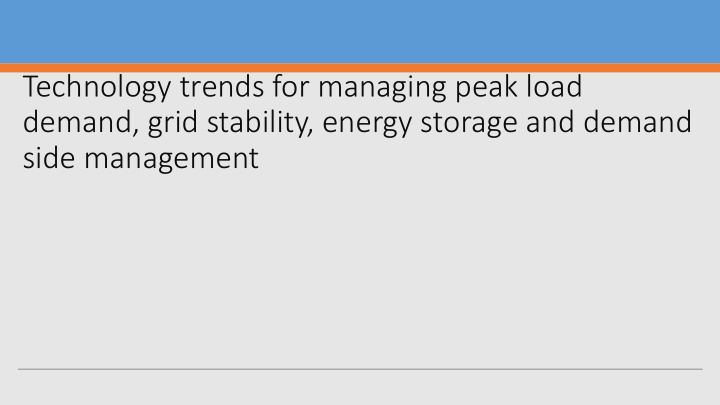



Technology trends for managing peak load demand, grid stability, energy storage and demand side management
A Platform for Integrating Technology Solutions Across the Grid • Large, centrally-located generation facilities • Distributed energy resources • Designed for one-way energy flow • Multiple inputs and users, supporting two-way energy flows • Utility controlled • Digitalization of the electro-mechanical infrastructure: smart grid and behind • Technologically inflexible the meter energy management systems • Simple market structures and transactions • Flexible, dynamic, and resilient • Highly regulated (rate base) and pass through • Complex market structures and transactions • Regulation changing rapidly around renewables, distributed generation (solar, microgrid, storage), net metering, etc.
Distributed Energy Resources (DER) We take a broad view of what encompasses DER. Distributed Generation Demand Response & Energy Efficiency • • Solar Direct Load Control • • Wind Price Based • • Turbines / Micro Turbine Virtual Power Plants • • Fuel Cells Incentive Based Distributed Storage Utility Side Loss Reduction • • Electrochemical conservation voltage reduction (CVR) • • Mechanical Voltage and VAR optimization (VVO) • • Thermal Grid Optimization Electric Vehicles Microgrid • EV Charging • On the Grid • • Customer EV to Grid
Drivers There are a number of drivers facilitating steady market growth. Technology Social • • Climate change mitigation is a major Falling prices • motivating factor Efficiency improvements • • Concerns about reliability and resiliency Improvements in equipment reliability • • Customer confidence in technology Greater product availability • Increasing availability of data Policy Financial • • Renewable energy targets Customer saves and/or hedges against • Regulatory reforms electricity rate fluctuations with self- generation • Dedicated businesses create efficiency The energy cloud represents a wide range of strategic, operational, technological, commercial, environmental, and regulatory changes that are transforming the traditional utility model for energy provision.
Peak Load and Energy Implement Direct Load Control • Leveraging existing programs and expanded capabilities Reduction Implement Rate Programs: • Peak time rebates (PTR) • Critical peak pricing (CPP) • Time of Use (TOU) • Real time pricing (RTP) Volt / VAR Optimization • Conservation Voltage Reduction (CVR) • Integrated Volt / VAR Control (VVO) More Detailed Information • Induce conservation for consumers • Displaying customers’ consumption allows streamlining and targeting DSM program to customers
Grid Reliability and Grid Reliability and Identification of Outage Locations Efficiency Efficiency • Locations identified faster and reduced labor time • Reduced Truck Rolls for “OK on Arrival” • Reduced Nested Outages • Reduced / Avoided CAIDI/SAIDI time and penalties Integration of Distributed Energy Resources • Monitor and balance load flow on feeders Load Flow Monitoring • Reduced energy losses from Volt VAR Optimization • High impedance detection • Reduced restoration costs Fault Location, Isolation and Service Restoration • Utilizing automated switches
Grid Stability, Grid Reliability and Energy Storage and Storage Efficiency DMS • Rapidly changing technology deveopment • Deployed at residential and utility level Stability • Storage as a means to stabilizing grid • Real time control DSM • Smart appliances
Utility Business Models Model Description Vertically integrated utility provides commodity energy to customers. Traditional • Utility owns, plans, operates (both physical and market operations), and maintains the distribution • system (and possibly also the transmission and generation assets). • Return of and on investment and cost recovery through rates, with oversight by PUC and rate cases. A variety of rate structures (de-coupled, performance based, etc. are possible). Functionally • Distribution utility is functionally separated from generation, which is out of the rate base. Utility owns, plans, operates (both physical and market operations), and maintains the distribution • Unbundled system. (several variants) • Investment and cost recovery mechanisms are the same as the Traditional model. Utility as • Utility owns the distribution assets and makes allowable investments based on the DSO planning process. Distribution Utility acts as independent DSO, and conducts market operations (market facilitation of DER and • System transaction management). Operator (DSO) • Utility as DSO also conducts physical operations (real and reactive power flow, outage restoration, switching, reliability coordination, and situational awareness). Value-Added In addition to any of the roles above, the utility is allowed to (and chooses to) provide additional • value-added services that may or may not be related to DER, such as: Service Provider* ― Behind-the-meter energy services (e.g., home energy management) ― Premium (i.e., higher reliability/quality) power supply * Can be combined with any of ― Warranties and financing for DER ― Ownership/operation of electric vehicle (EV) charging stations the above ― Operations and maintenance of third-party owned DER
Utilities in the Changing Energy Market • Technology is no longer an issue • Need to change business approach • The need for regulatory changes to accelerate RE/EE uptake
Recommend
More recommend